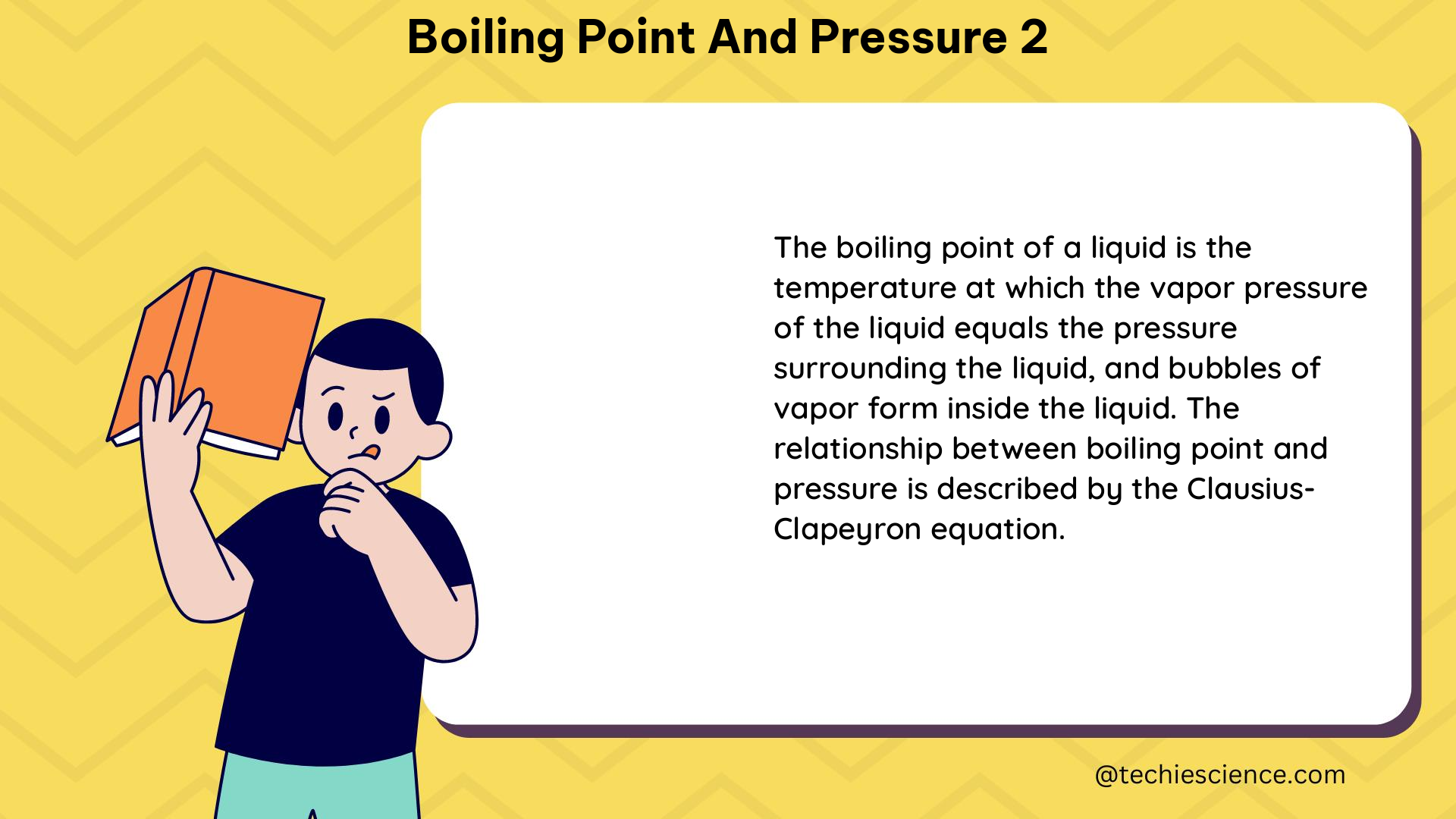The boiling point and pressure 2 are closely related concepts that are based on the equilibrium between the liquid and vapor phases of a substance. The boiling point of a liquid is the temperature at which its vapor pressure is equal to the external pressure, while the pressure 2 refers to a specific pressure value of 2 atmospheres.
Understanding the Antoine Equation
The Antoine equation is a widely used formula for calculating the vapor pressure of a liquid at a given temperature. The equation takes the form:
log10(P) = A – (B / (C + T))
Where:
– P is the vapor pressure in mmHg
– T is the temperature in degrees Celsius
– A, B, and C are substance-specific constants
For water, the Antoine equation constants are:
– A = 8.07131
– B = 1730.63
– C = -233.426
Using these constants, the vapor pressure of water at a given temperature can be calculated as follows:
log10(P) = 8.07131 - (1730.63 / (T - 233.426))
This equation allows us to determine the vapor pressure of water at any temperature, which is crucial for understanding the boiling point.
Calculating the Boiling Point at Pressure 2

The boiling point of a liquid is the temperature at which its vapor pressure is equal to the external pressure. At pressure 2 (which is equivalent to 2 atm or approximately 1013.25 hPa), the boiling point of water can be calculated using the Clausius-Clapeyron equation:
ln(P2/P1) = -ΔHvap / R * (1/T2 – 1/T1)
Where:
– P1 and P2 are the vapor pressures at temperatures T1 and T2, respectively
– ΔHvap is the heat of vaporization
– R is the gas constant
Rearranging the equation to solve for T2 (the boiling point at pressure 2), we get:
T2 = 1 / (1/T1 + (R * ln(P2/P1)) / ΔHvap)
Substituting the known values:
– P1 = 100 mmHg (1 atm)
– P2 = 1013.25 mmHg (2 atm)
– ΔHvap for water ≈ 40.65 kJ/mol
– R ≈ 8.314 J/(mol·K)
We can calculate the boiling point of water at pressure 2 as:
T2 = 1 / (1/373.15 + (8.314 * ln(1013.25/100)) / 40650)
T2 ≈ 393.75 K (120.6°C)
Therefore, the boiling point of water at pressure 2 is approximately 120.6 degrees Celsius.
Practical Applications and Considerations
The relationship between boiling point and pressure has numerous practical applications in various fields, such as:
-
Cooking and Food Processing: The boiling point of water is affected by pressure, which is important in cooking and food processing. At higher altitudes, where the atmospheric pressure is lower, water boils at a lower temperature, requiring adjustments to cooking times and methods.
-
Chemical Processing: The boiling point and pressure relationship is crucial in chemical processing, where the control of pressure and temperature is essential for efficient distillation, evaporation, and other unit operations.
-
Power Generation: In steam power plants, the relationship between boiling point and pressure is used to optimize the efficiency of the steam turbines, which rely on the phase change of water to generate electricity.
-
Aerospace and Automotive Engineering: The boiling point and pressure relationship is important in the design of pressurized systems, such as aircraft cabins and automobile cooling systems, to ensure the proper functioning of these systems under varying pressure conditions.
-
Meteorology and Climate Science: The boiling point and pressure relationship is used to understand the behavior of water in the Earth’s atmosphere, which is crucial for weather forecasting and climate modeling.
It’s important to note that the boiling point and pressure relationship is not limited to water and can be applied to other substances as well. The specific constants and equations used may vary depending on the substance, but the underlying principles remain the same.
Conclusion
The boiling point and pressure 2 are fundamental concepts in physics and chemistry, with numerous practical applications in various fields. By understanding the relationship between these two variables, as well as the underlying equations and principles, we can gain valuable insights into the behavior of substances and optimize various processes and systems.
References
- “Vapor Pressure and Boiling Point Correlations” by University of Wisconsin-Madison, accessed on June 24, 2024, https://wisc.pb.unizin.org/chem103and104/chapter/vapor-pressure-m10q3/
- “Quantitative structure-property relationships for prediction of boiling points, vapor pressures, and melting points” by Seto et al., accessed on June 24, 2024, https://onlinelibrary.wiley.com/doi/full/10.1897/01-363
- “Dependence of Boiling Point of Water on Pressure” by Physics Experiments, accessed on June 24, 2024, https://physicsexperiments.eu/1707/dependence-of-boiling-point-of-water-on-pressure
Hi…..I am Harshitha H N. I have completed my master’s in Physics from the University of Mysore with a specialization in Nuclear physics. I enjoy exploring new things in my free time. My article always aims to develop and bring some value to the table with relevant topics.
Let’s connect through LinkedIn-